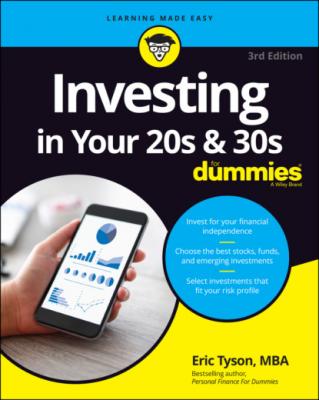Investing in Your 20s & 30s For Dummies. Eric Tyson
Чтение книги онлайн.
Читать онлайн книгу Investing in Your 20s & 30s For Dummies - Eric Tyson страница 12
 advisor. How can you possibly evaluate the competence of someone you may hire if you yourself are financially clueless? You’ve got this book, so read it before you consider hiring someone for financial advice.
advisor. How can you possibly evaluate the competence of someone you may hire if you yourself are financially clueless? You’ve got this book, so read it before you consider hiring someone for financial advice.
By taking the themes and major concepts of this book to heart, you greatly minimize your chances of making significant investment blunders, including hiring an incompetent or unethical advisor. You may be tempted, for example, to retain the services of an advisor who claims that he and his firm can predict the future economic environment and position your portfolio to take advantage. But you find in reading this book that financial advisors don’t have crystal balls and that you should steer clear of folks who purport to be able to jump into and out of investments based upon their forecasts.
Because investment decisions are a critical part of financial planning, take note of the fact that the most common designations of educational training among professional money managers are MBA (master of business administration) and CFA (chartered financial analyst). Financial planners often have the CFP (certified financial planner) credential, and some tax advisors who work on an hourly basis have the PFS (personal financial specialist) credential.
You can ask the advisor to send you a copy of his Form ADV. You can also find out whether the advisor is registered and whether he has a track record of problems by calling the SEC at 800-732-0330 or by visiting its website at www.adviserinfo.sec.gov. Many states require the registration of financial advisors, so you should also contact the department that oversees advisors in your state. Visit the North American Securities Administrators Association’s website (www.nasaa.org), and click the Contact Your Regulator link on the home page.
Chapter 2
Using Investments to Accomplish Your Goals
IN THIS CHAPTER
Saving and investing money can make you feel good and in control. Ultimately, most folks are investing money to accomplish particular goals. Saving and investing for a car purchase, expenses for higher education, a home purchase, new furniture, or a vacation are typical short-term goals. You can also invest toward longer-term goals, such as your financial independence or retirement decades in the future.
In this chapter, I discuss how you can use investments to accomplish common shorter- and longer-term goals.
Setting and Prioritizing Your Shorter-Term Goals
Unless you earn really big bucks or expect to have a large family inheritance to tap, your personal and financial desires will probably outstrip your resources. Thus, you must prioritize your goals.
One of the biggest mistakes I see people make is rushing into a financial decision without considering what’s really important to them. Because many people get caught up in the responsibilities of their daily lives, they often don’t take time for reflection often because they feel that they lack the time. Take that time, because people who identify their goals and then work toward them, which often requires changing some habits, are far more likely to accomplish something significant.
In this section, I discuss common “shorter-term” financial goals — such as establishing an emergency reserve, making major purchases, owning a home, and starting a small business — and how to work toward them. Accomplishing such goals almost always requires saving money.
Accumulating a rainy-day fund
The future is unpredictable. Take the uncertainty simply surrounding your job: You could lose your job, or you may want to leave it.
Consider what happened in 2020 with the COVID-19 pandemic and the unexpected and lengthy government-mandated shutdowns in some parts of the country, which led to large layoffs in particular industries like restaurants, retail, and travel-related businesses. While the 2020 recession was unusual in many respects, recessions aren’t unusual and even when the overall economy is growing, some employers let employees go. Suppose an elderly relative, for example, needs some assistance for a period of time? Look, I’m not trying to be a pessimist or negative, but problems happen, and sometimes there are financially downsides that can come with them.
Because you don’t know what the future holds, preparing for the unexpected is financially wise. Enter the emergency or rainy-day fund.
The size of your emergency fund depends on your personal situation. Begin by considering how much you spend in a typical month. Here are some benchmarks for how many months’ worth of living expenses you should have:
Three months’ living expenses: When you’re starting out, this minimalist approach makes sense if your only current source of emergency funds is a high-interest credit card. Longer-term, you could make do with three months’ living expenses if you have other accounts, such as a 401(k), or family members and close friends whom you can tap for a short-term loan.
Six months’ living expenses: If you don’t have other places to turn for a loan, or if you have some instability in your employment situation or source of income, you need more of a cushion.
Twelve months’ living expenses: Consider this large a stash if your income fluctuates greatly or if your occupation involves a high risk of job loss, finding another job could take you a long time, or you don’t have other places to turn for a loan.
Saving